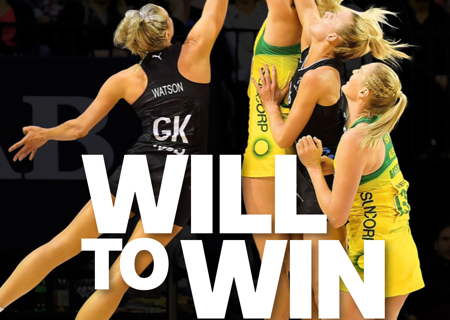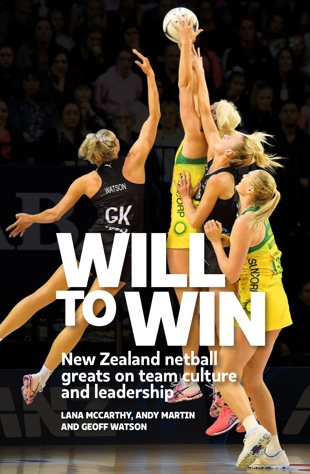Q1: Netball is hugely popular in New Zealand. What is it that has made it such a favourite of New Zealand girls and women?
AM: Traditionally netball has been a sport played, coached, managed and administered by women, which is a unique aspect of the game that has endeared it to generations of girls growing up in New Zealand.
GW: Netball is a very democratic sport, in that almost every New Zealand small town and suburb has its own court, and many women have played the game at some level. The Silver Ferns have consistently been excellent role models, giving freely of their time in interviews and interacting with the public because they do not take their support for granted. In more recent times, the fact that players have been able to return to international netball after having children has been a very empowering statement for many women.
Q2: What was your motivation for writing the book?
LM: During my research, I gained such valuable insights into the culture and leadership of the Silver Ferns that I wanted to share this knowledge not only with netball fans, but with all sporting enthusiasts. Much of what this book is about can be used by coaches and players of various sports and at all levels.
GW: There has been very little written on women’s high-performance sport in New Zealand, and the lack of any detailed study on the leadership and culture of New Zealand’s leading team sport, in terms of participation, seemed a major gap.
Q3: Was there anything you discovered through the interviews that surprised you?
LM: I have always followed the Silver Ferns, but what surprised me most during the interviews was the strong emotions and memories, passion and love for the game that were elicited often years after those interviewed had played in or coached the team.
Q4: Why are there so few books written about New Zealand netball?
AM: Female sport in general, and female high-performance sport specifically, is not well served by the media. Scholarly work on women’s sport receives even scanter coverage. We hope the recent increased profile of women’s elite professional sport and this book start to address these issues.
GW: I think that unfortunately many publishers believe there is not a market for books on women’s sport. The first biographies of sportswomen in New Zealand did not appear until the 1970s, more than 70 years after the first New Zealand books on rugby.
Q5: What do you want readers to take from the book?
LM: I hope that potential or current coaches and players take away an understanding and an appreciation of the importance of developing a positive team culture. It has a huge impact on team performance, player enjoyment, and longevity of involvement in sport.
GW: Pride in preparation and personal performance were consistent themes in the interviews. Even in the amateur era, players had a professional approach to fitness and training. Professionalism is not simply being paid to play sport, it is a mindset that demands a constant commitment to excellence, on and off the court. This is exemplified in the belief you are a Silver Fern 24/7.
Q6: What elements make up the leadership styles and team culture of the Silver Ferns?
AM: What is evident from the interviews is that one leadership or coaching style does not work for all. Team culture, leadership and coaching have evolved, and there is a need for coaches and managers to have a more flexible, collective approach combining at times both autocratic and empowerment styles.
GW: The Silver Ferns are broadly similar to many New Zealand teams, perhaps with a particular emphasis on leading by example as a captain, because it is such a fast-moving game that there are few breaks in play.
Q7: The rivalry with Australia is a constant throughout the eras. Did it loom large for the coaches and captains interviewed?
LM: The Silver Ferns evaluated and compared their own performance against the Australians. How well they performed was measured by how well they competed (and how often they won) against the Australian Diamonds.
AM: Both coaches and captains spoke passionately about this rivalry, highlighting the Diamonds’ strong winning attitude and mental toughness, but also pointing out how competitive New Zealand tends to be despite the greater depth of players in Australia.
Q8: What was it like to talk in-depth about the game with your netball heroes?
LM: To have spoken with these legends of New Zealand netball will be one of the most memorable highlights of my life. It was an amazing and unique opportunity. Each interviewee was incredibly lovely and extremely supportive of this research. I am beyond appreciation for their involvement, as this book would not have been possible without them.
Q9: What era would you most like to have played in?
LM: In those earlier eras, the players and coaches really had to do a lot for themselves with very little financial support and minimal, if any, development or training opportunities. I would personally most like to play in the latest era, as the financial support, funding, extended management (physio, nutritionists, trainers, specialist coaches, etc.), are all available. There is also training and development for the players and coaches, specifically in relation to dealing with the media and sponsorship demands.
AM: The earlier coaches and captains highlighted playing for the love of the game and the camaraderie that existed. They were professional but not paid, and made the most of every opportunity. An ideal era in which to be playing.
Q10: If you could give coaches one piece of advice, what would it be?
LM: Understand that coaching is just as much about learning and developing as it is for the players, and it is just as important. As a coach, you must be willing to learn, adapt, communicate, respect others in order to be respected, value every single person involved and embrace a ‘team’ culture.
AM: There is no perfect coach, there is no one way to coach. A coach needs to communicate their vision to the team, which should be based on observations of the players, contexts and opposition.
GW: Be yourself. The coaches interviewed for this book had a strong sense of who they were and what they wanted from their teams, and had the ability to ‘sell’ their vision to the players. Players responded to them because they saw that the coaches genuinely cared about them and knew what they were talking about.


